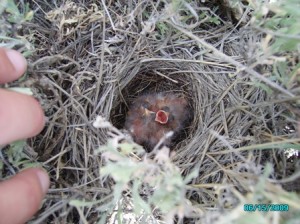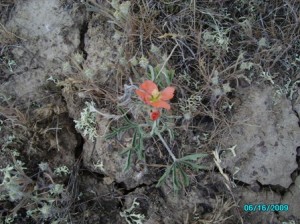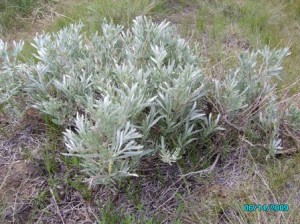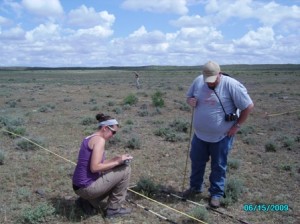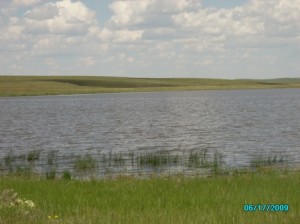These past three days, I’ve been accompanying Lauren Smith and Marisa Lipsey, two interns at the BLM, on various surveys. Matt Tribby has been our field advisor, and the man knows how to drive off-road! Marisa, Lauren, and Matt have been studying the vegetation at various sage grouse leks to identify key habitat factors. A lek is a courtship site used concurretly by several males to attract females, and the leks that we are currently investigating were active as of this spring (unfortunately, I missed the spectacular sage grouse courtship displays). However, at our first site, we saw a Sprague’s pipit nest with nestlings, which was extremely exciting because Sprague’s pipit is a species of special concern. And at the second site, we saw a green-winged teal nest with eggs.
The vegetation surveys go something like this: we set up a large 50 x 20m rectangle and a smaller rectangle within it. We then identify *all* of the plants present at smaller plots at the perimeters of these rectangles. Thanks to the expertise of these three, I’ve learned quite a few plants including: scarlet globemallow (quite a pretty little red flower), greasewood, foxtail barley (I’m fairly certain we have this in California too), and prickly pears! The sites we studied were in South Valley County, and there are several different sagebrush plants that grow here. John explained that this is a result of the fact that south of the Milk River (a river that divides Valley County into North and South Valley Counties), Artemesia frigida, Wyoming big sage (also genus Artemesia), and Silver sage can all grow. North of the Milk River–our MAPS site is located here–silver sage dominates.
The next day we went on a waterfowl survey at three sites. The first was near the town of St. Marie, a former Army base that closed in the late 1960s, and since then, has had a very small population size. We saw killdeer, spotted sandpipers, upland sandpipers, marbled godwits, willets, Wilson’s phalarope, Red-winged blackbirds, Yellow-headed backbirds, and Brewer’s blackbird. This was the first time that I have ever seen and identified Wilson’s phalarope, which is a small wading bird with a black streak on its neck. We also observed painted turtles basking on the sides of the pond, and a killdeer nest with precocial nestlings.
We subsequently went to Base Pond, which was immediately adjacent to that first pond, and saw Green-winged teals (a type of duck), more killdeers, blackbirds, and godwits, and Eastern Kingbirds. I’d been to this site before with my neighbor, a Montana Fish Wildlife and Parks intern named Josh, and while he was fly-fishing, I went a-birding. I saw two barn swallows and a small mud nest they made in a gazebo near the pond, and I was pleased to see them again, flycatching over the water for their nestlings. We also saw Common Nighthawks lazing on fenceposts on the drive to St. Marie and flying overhead at the pond. In the trees nearby, there were yellow warblers and potentially a Common yellowthroat.
En route to our final site, we passed by a Swainson’s hawk with a large messy nest. This was another first for me, and Swainson’s hawks are buteos, a genus of birds characterized by their broad wings. Our last site was Saskeview Reservoir, which is just 0.5 mi south of Canada, and we saw an immense amount of eared grebes (~50), and a large amount of ducks (teals, buffleheads, pintails). There were more phalaropes and blackbirds, but what was especially exciting is that I saw a Sprague’s pipit, a small bird that is a species of special concern in Montana, and a Chestnut-collared Longspur. The Chestnut-collared longspur has a boldly patterned face, a black belly, and a chestnut patch on the back of its neck.
Tomorrow I’ll be learning how to drive the pickup truck to the MAPS site, and hopefully I’ll see some more cool birds on the way.

